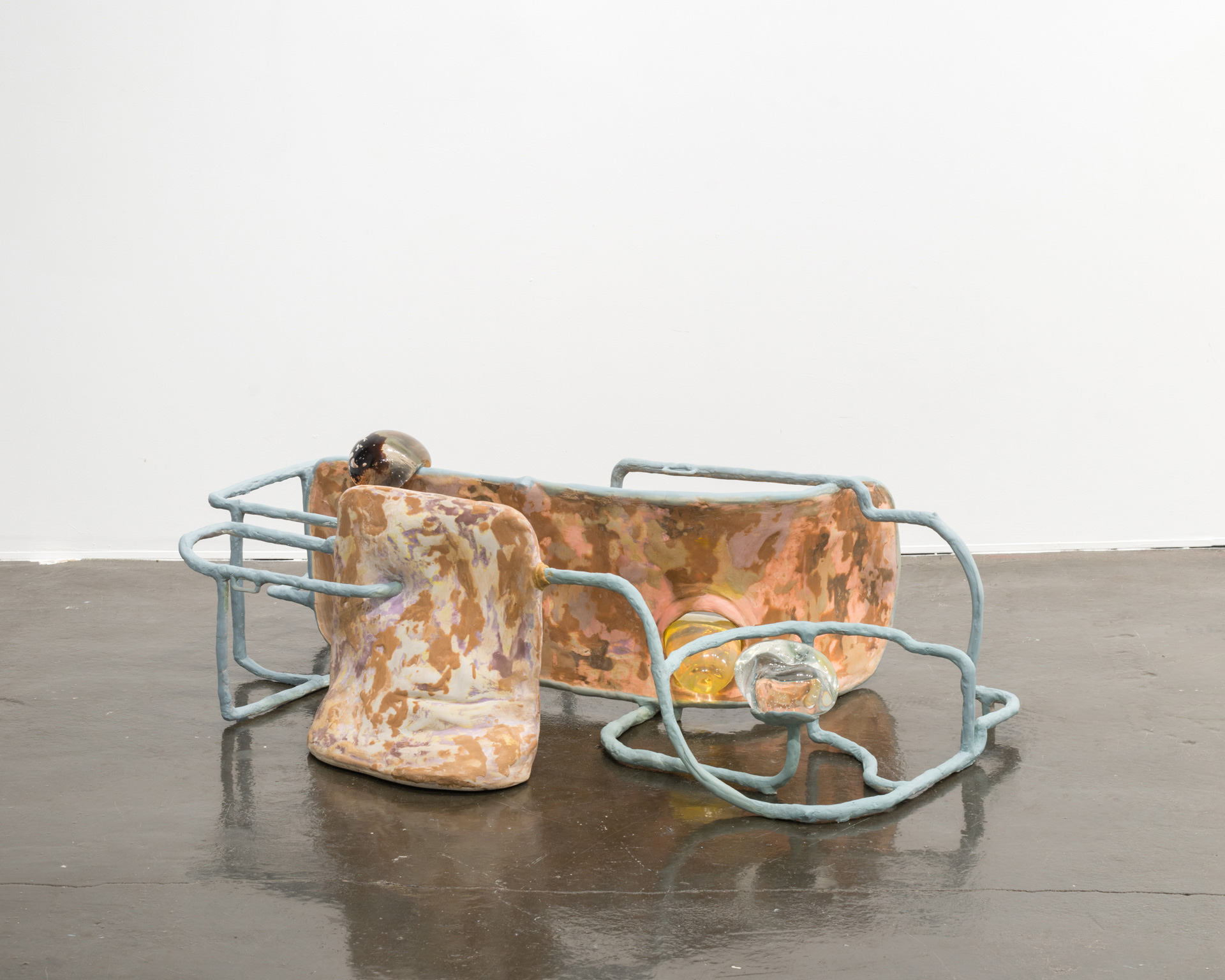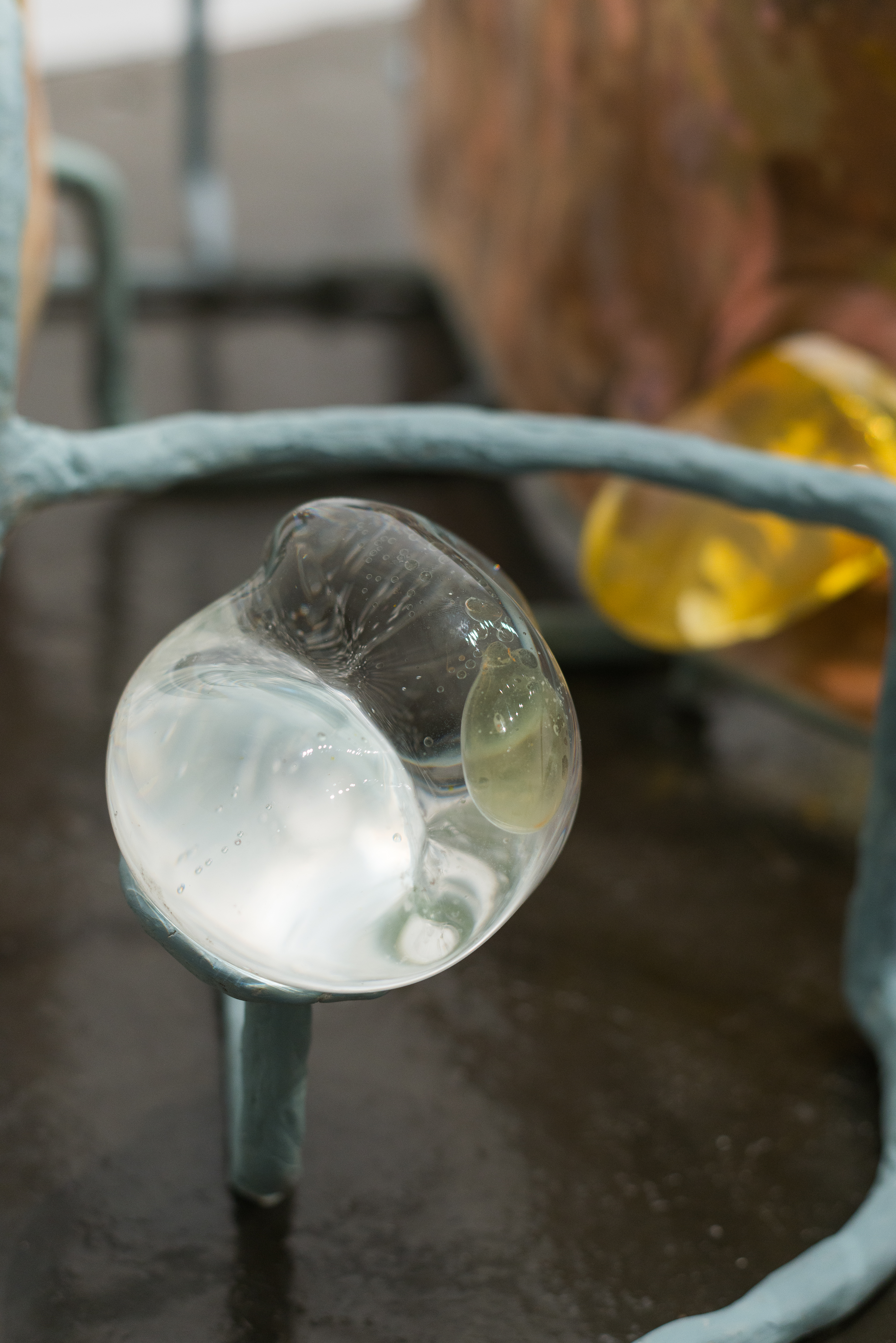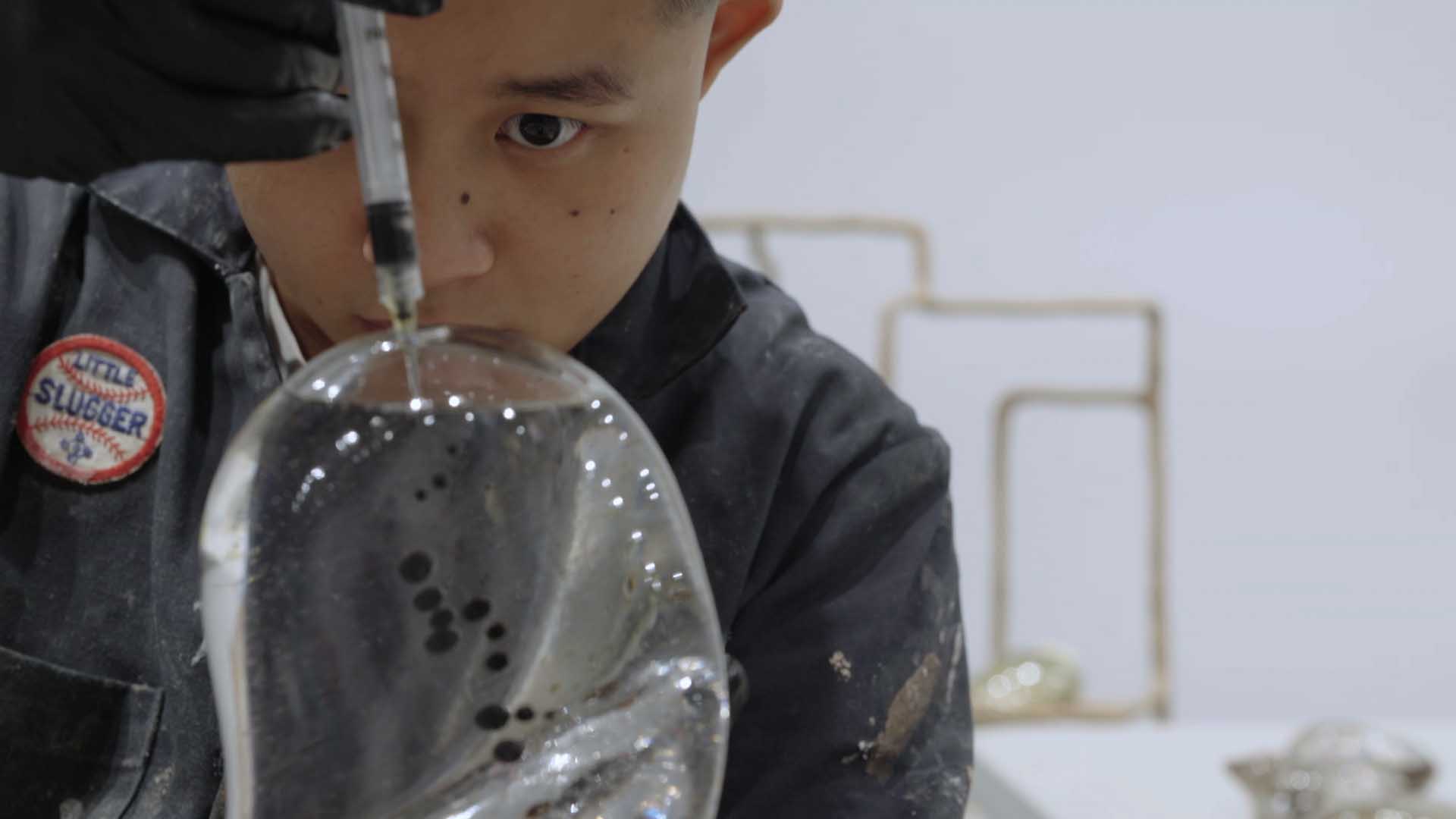
Jes Fan. Systems III, 2018. Silicone, Glass, Epoxy, Melanin, Glass, Estradiol, Wood; 48″x25″x19″. © Jes Fan. Courtesy of the artist.
Jes Fan’s recent work explores the material bases of identity by working with isolated natural chemicals such as melanin, estrogen, and testosterone. Fan suspends these liquids in blown glass, and the contrast between their innocuous, whimsical appearance and the ideologies of racial and gendered power that they buttress is absurd, almost incomprehensible. Systems III (2018) is emblematic of this series: a fleshy lattice reminiscent of circuitry, scaffolding, or plumbing that evokes the body, with its sags and folds. Fan’s work is often couched in discourses of identity and their co-optation within biopolitical capitalism. Here, instead, I offer a personal take on one work, Systems III, by comparing it to three creative forms—a poem, essay, and song—which have stimulated my thinking and helped me to understand Fan’s work, toward reshaping the boundaries between what we know and what we fear about ourselves.
A poem: “Study of Two Figures (Pasiphaë/Sado)” by Monica Youn
This poem by Monica Youn considers two mythical figures: Pasiphaë, a princess of Crete who was cursed by Poseidon to climb into a wooden cow in order to have sex with a bull, eventually birthing the Minotaur; and Sado, a Korean prince who is sentenced to death in a rice container. For Youn, the physical containers holding these protagonists pale in comparison to the linguistic containers of identity (female, Asian) that lead them to their fates.
“Both works ask us to reconsider what containers hold us into ourselves.”
Youn, like Fan, considers the arbitrariness of these containers—nationalism, race, gender—as they have come to restrain and fix certain life trajectories: “Revealing a racial marker in a poem is like revealing a gun in a story or like revealing a nipple in a dance.”¹ Both understand that the body is not a container for the ingredients of one’s identity; identity exists within the body and extends beyond it. In Fan’s Systems III, glass globules contain droplets of testosterone, melanin, and estrogen. However, as these chemicals appear as suspended, whimsical speckles in glass, their significance is not manifested on the surface of their container, as they are when they are contained within a human being. Rather, they persist in a frozen state of interiority, as if replicating the restricting logic of racial and gendered containers: to be no more than the sum of the chemicals that are suspended within. Fan’s work visualizes the intractability of this identity model, as Youn’s poem does in its relentless logic of entrapment. Both works ask us to reconsider what containers hold us into ourselves.

Jes Fan. Systems III, 2018. Closeup. Silicone, Glass, Epoxy, Melanin, Glass, Estradiol, Wood; 48″x25″x19″. © Jes Fan. Courtesy of the artist.
An essay: “The Sucker, the Sucker!” about the octopus, by Amia Srinivasan
With its fleshy scaffolds and the drooping, translucent weight of the glass, Systems III resembles an octopus. The mottled, pale pinks of its surfaces make me think of glossy, wet skin; the blue pipes are like arms extending inside and outside of itself, in alien repose.
Like humans, they [octopi] have centralised nervous systems, but in their case there is no clear distinction between brain and body. An octopus’s neurons are dispersed throughout its body, and two-thirds of them are in its arms: each arm can act intelligently on its own, grasping, manipulating and hunting.²
“What might it be like to think through your body, to communicate to your arms—to all parts of yourself—the way an octopus does?”
The octopus has more neural matter in its arms than in its head. These networks are separate, but they correspond with one another. In a way, an octopus can have conversations with itself. Systems III is a schematic for this sort of self-Othering and mind-body melding. The tubing resembles arms and is like the system of neural pathways encased in dermis. The surfaces ripple as if electric with thoughts and emotions. Systems III encounters a viewer as a proposition: Can you think like this, with your body?
This melding of the mental and the physical is a soothing rejoinder to the insistent division of mind and body in Cartesian logic, so beloved by the cerebral space of the gallery. What might it be like to think through your body, to communicate to your arms—to all parts of yourself—the way an octopus does? If the nature of an octopus reveals that, in some ways, we are always an Other to ourselves, it also implies that this othering is not necessarily a cause for despair, but a site of potential, even celebration.

Jes Fan, injecting a silicone filled glass globule with a substance. Production still from the New York Close Up episode, “Jes Fan In Flux.” © Art21, Inc. 2019.
A song: “Chorus” by Holly Herndon
Holly Herndon makes music by teaching an artificial neural network (lovingly named Spawn) how to sing. She inputs pop and dance music as well as vocal samples from YouTube, Skype, and other audio sources from the digital landscape, like beeps and dings for email and other notifications. The result of this collaboration between Herndon and her AI network is a slippery, ethereal soundscape.
“It’s a remix of the body”
Herndon and Fan share an outlook toward technology that is measured, a desire to see it as neither the best nor the worst thing ever. Herndon’s manipulated voice throbs and whirrs in a way that is both pleasurable and unsettling. Familiar sounds like email alerts and keyboard clatter are loosed from their normal usage, made harmonic. Similarly, Fan collaborates with laboratories to explore the lives of natural chemicals outside of their pharmaceutical administration; Systems III is a body or several bodies, with two flesh-like panels facing away from each other. Flesh, bone, and hormones appear separated, in pink panels, blue tubes, and glass globules. It’s a remix of the body, and of the self, with its psychic and physical barriers rearranged.
As our bodies and creativities are peppered with adjustments by emerging technologies, Fan, as well as Herndon and Youn (and octopi) are not that interested in shoring up the borders of any single body. Rather, they hope to open those borders toward an increased porousness: the understanding that technology—in the form of nervous systems, animals, consciousness, AI, or natural chemicals—has always been with us and within us, both foreign and familiar.



